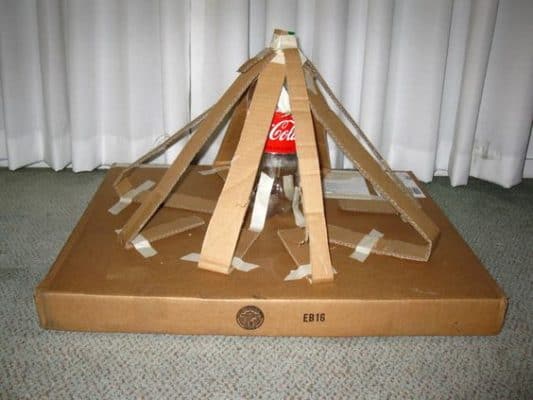Create an Awesome Paper Mache Volcano with Your Kids
Hey there, super-cool parents and curious kids! Are you ready to dive into one of the most thrilling and mess-approved DIY science projects? Yes, I’m talking about the classic and awe-inspiring paper mache volcano! Not only is this a blast to make (and to watch erupt), but it’s also a fantastic way to combine creativity with a little bit of Earth science learning. Strap in, because we’re about to get crafty!
What You’ll Need for Your Paper Mache Volcano
Before we unleash the power of Mount Craftmore, let’s make sure you’ve got all the essentials. Gather your little scientists and embark on a mini-adventure around the house or to your local craft store to snag these items:
- Old newspapers or paper towels
- Flour and water (or ready-made paper mache paste)
- Balloons or a small container for the volcano structure
- Cardboard or a sturdy base
- Paint and brushes
- Red food coloring, baking soda, and vinegar for the eruption!
Feeling ready? Great! Now, let’s break down the process into some super simple steps that even the most craft-challenged among us can follow.
Step 1: Building the Base of Your Volcano
First off, we’re going to construct the foundation of our soon-to-be magnificent peak. If using a balloon, blow it up and tie it off – this will form the shape of your volcanic dome. Place it upside down (tied-end down) on a cardboard base, which you can cut into a circle or square for stability. If you’re using a container, simply place it on the cardboard, and now you’ve got yourself a mold!
Step 2: The Art of Paper Mache
Mix equal parts flour and water to form a smooth paste. If it’s too thick, add a bit more water; too runny, more flour. You’re aiming for a consistency similar to that of craft glue. Tear your newspaper or paper towels into strips — these will become the “lava rock” of your volcano.
Dip a strip into the paste, making sure it’s well-coated. Wipe off excess paste with your fingers and place it over your mold. Cover the entire mold with a layer of paper strips, making sure to leave the opening at the top if you’re using a container. Overlap the strips and smooth out air bubbles as you go. Once you’ve got your first layer, you can add one or two more for extra strength. Now, the waiting game begins!
Your volcano will need to dry completely before you can move onto painting. This could take up to 24 hours, depending on humidity and the thickness of your layers. Patience is a virtue, especially in the crafting world, but think of the anticipation building up to your epic eruption!
While waiting for the volcano to dry, this can be the perfect time to chat with your kiddos about volcanoes. Discuss how they form, why they erupt, and the different types of volcanoes in the world. Turn this crafting session into a memorable science lesson with the power to spark a life-long interest in geology!
Stay tuned because, in the next section, we’re going to add some fiery color to our project and prepare for a volcanic eruption that will have the whole family “ooohing” and “ahhhing!”.
The creation of a paper mache volcano is a fantastic way for kids to learn about science while getting hands-on and dirty, which we all know is a key ingredient in the recipe for childhood fun. So, let that inner artist and scientist run wild as you continue on this explosive journey!

5 Things Parents Should Know in Preparing for Paper Mache Volcano
Before we move on to painting and erupting our majestic volcano, let’s tackle some essential tips to help parents prepare:
- Prepare Your Space: Paper mache can get messy! Lay down plastic sheets or old newspapers to protect your surfaces, and have a cleanup kit ready. Wearing old clothes or aprons is also a smart move.
- Keep a Balanced Schedule: This can’t be done in a sprint; it’s more of a fun-filled marathon. Make sure you allocate time for drying, which is perfect for breaks or a good night’s sleep.
- Patience is Key: Wait for each layer to dry thoroughly to prevent mold and ensure structural integrity. Remember, good things come to those who wait – and that applies to paper mache too!
- Safety First: While non-toxic, it’s still wise to supervise every step, especially if younger children are involved. Keep small items out of reach, and ensure everything used is safe and age-appropriate.
- Embrace the Learning Opportunity: As you build, discuss the science behind what you’re doing. Why is the volcano’s structure important? How will the chemical reaction cause the eruption? Turn this into a rich educational experience.
Bringing Your Volcano to Life with Color
When your sculpture is totally dry, it’s time to paint! Unleash your child’s inner Michelangelo and let their creativity shine. Paint the outside to resemble a real volcano – think about using a mix of browns, greens, and grays for realism, or go wild with a fantasy volcano! Browns and dark reds can simulate rock; bright red, orange, and yellow can mimic flowing lava. Once the paint dries, it’s almost showtime!
Step 3: The Exciting Eruption!
This is the moment we’ve all been waiting for! Move your volcano to an open space, ideally outside if you can. It’s going to get messy, but that’s half the fun, right?
Mix a few drops of red food coloring with vinegar in a separate cup for a true lava-like effect. Add a generous amount of baking soda into your volcano’s crater. Now, with a drumroll (optional but highly recommended), pour the colored vinegar into the crater and watch as your volcano comes alive with a frothy, bubbly eruption!
Pro Tip: For an even more impressive eruption, add a squirt of dish soap to your baking soda before adding the vinegar to intensify the foam!
Being Environmentally Friendly
Ditching single-use plastics for this project is a win for mother Earth. By using recyclable materials like old newspapers and cardboard, you’re fostering environmental awareness in your kids. When disposing of your volcano, consider recycling what you can, and remember, the kitchen ingredients used are biodegradable!
The creation of a paper mache volcano with your little ones is not just about crafting; it’s about sharing unforgettable moments and lessons that go far beyond the realm of science. So, what are you waiting for? Create, erupt, and learn with one of the most engaging projects you can enjoy at home.
And remember, the journey doesn’t end with the eruption. There’s always room for more experiments, artistic details, or even starting from scratch with a new twist. Keep the exploration spirit alive, and may your volcanoes always erupt with joy and knowledge!
See more great Things to Do with Kids in New Zealand here. For more information see here
Disclaimer
The articles available via our website provide general information only and we strongly urge readers to exercise caution and conduct their own thorough research and fact-checking. The information presented should not be taken as absolute truth, and, to the maximum extent permitted by law, we will not be held liable for any inaccuracies or errors in the content. It is essential for individuals to independently verify and validate the information before making any decisions or taking any actions based on the articles.




